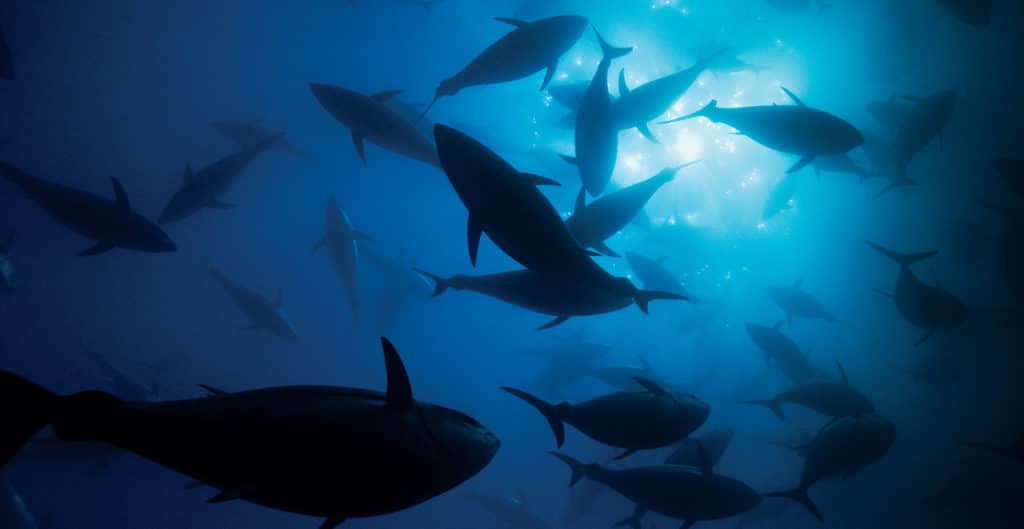
I love those rare winter days when everything comes together: calm seas, light winds, bright sun and giant bluefin tuna crashing schools of chopper bluefish on the surface.
On just such a bright March day, I was standing on the bow of Wasabi, a classic Carolina charter boat, 40 miles off the coast of Hatteras Island, North Carolina. “Not yet!” Capt. Kenny Koci hollered from the bridge. “Wait for it!” Koci is way over 6 feet tall, bald and bulging with muscles. I felt like I had Sasquatch sitting on my shoulder. “Not yet!” he repeated.
The boat slowly moved toward the melee. I held an oversize spinning rod I had armed with an oversize popper. Since we already had a bluefin in the box, I had removed the hooks from the popper. I was looking for an encounter, not a long-term relationship.
Fifty yards in front of me, a tightly packed school of big bluefish swirled on the surface. Every few seconds, the water around the school exploded as a giant bluefin picked off another victim.
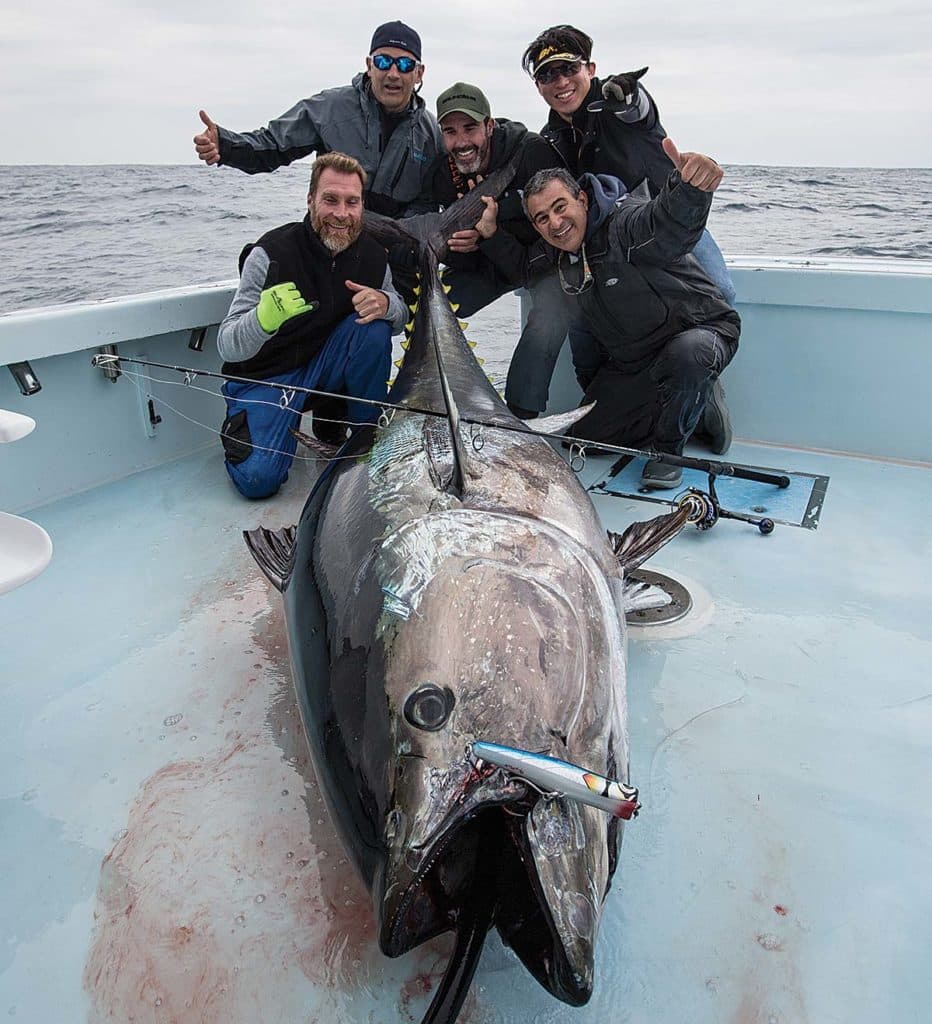
“Get ready,” Koci barked from behind me. I opened the bail and felt a twinge of dread. What am I getting myself into? As we got closer, I could see the huge tuna darting through the school of terrified bluefish.
“Make the cast!” Koci ordered. I obeyed, landing the plug a few feet past the school. I turned the reel handle and jerked the rod tip to make the plug pop on the surface. Then I paused. Pop and pause. Pop and pause. On the third pop, the lure disappeared into a black void, followed by a car-size boil.
Line raced off the reel, and the rod bent to severe pressure. I braced as the fish dragged me across the bow. Just before I reached the edge, the fish let go of the lure, sending the plug ricocheting back at me. My anxiety broke into laughter. “That was fun!” I raved. “Let’s do it again!”
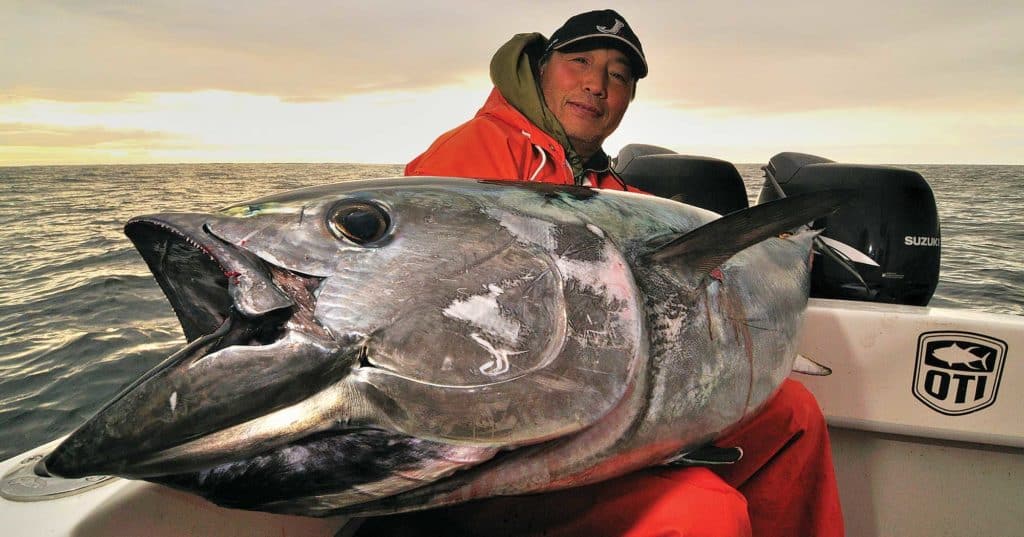
Bluefin Timing
If you define true game fishing as targeting the biggest fish with the lightest possible tackle, then chasing bluefin with jigs and topwater baits creates the ultimate challenge. Each winter, big-fish junkies from all over the world come to Hatteras for a shot at giant bluefin with jigs and plugs.
Capt. Dan Rooks, who runs Tuna Duck out of this famed Outer Banks port, has been hosting these “finatics” since 2010. “When the bluefin first showed up that winter, a group of guys chartered me for light-tackle jigging,” says Rooks, recalling his shock when the crew showed up with spinning and jigging rods. “Guys on the dock thought it was ridiculous.”
On the first trip, they scored half a dozen 200-pound bluefin and birthed a new fishery.
Today, the docks and tackle shops around Hatteras and Oregon Inlet crawl with similar anglers looking for a shot at glory. “They come from everywhere,” Rooks marvels. He has hosted anglers from Russia, Japan, Europe and beyond. “There’s nowhere in the world like Hatteras,” he says. “It’s the best place to catch an 800-pound bluefin with a spinning rod.”
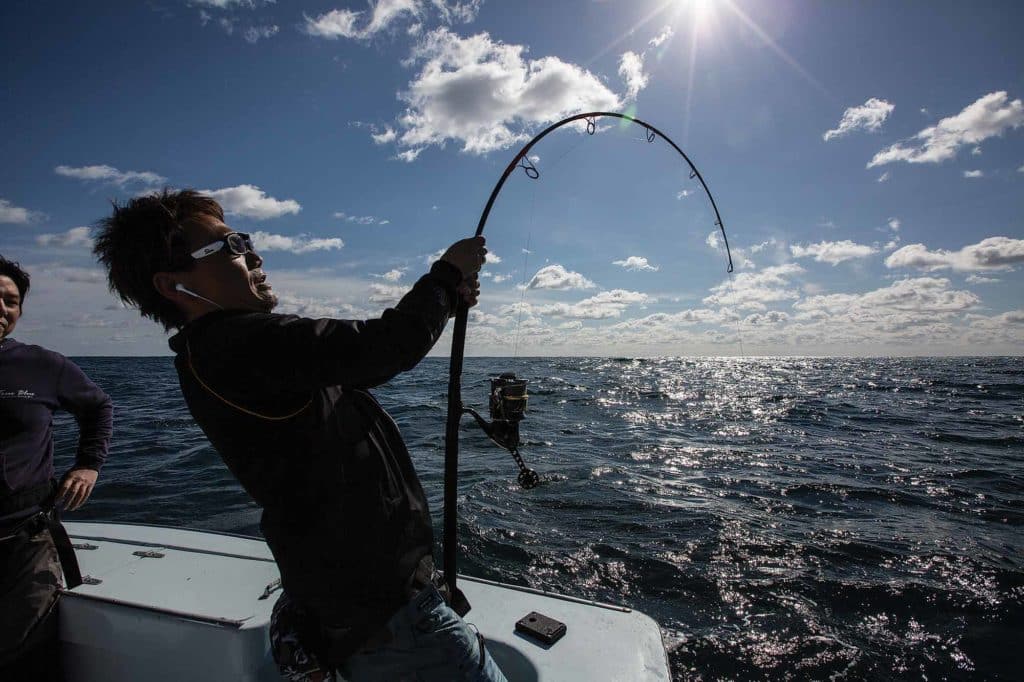
Rooks catches bluefin as early as Halloween and as late as two weeks after Easter, but the best months are February through early April. The first push of fish comes through in November. “The fish are shallow, in cooler water,” he says. He looks for an early bite in 72-degree water over 120- to 300-foot depths, as close as 10 to 20 miles off the beach. He expects the fish to be scattered. “Once you find the tuna, you can get them to bite a plug or jig.”
Rooks theorizes that in the early season, the tuna are migrating south, feeding on menhaden. “Take everything you know about water clarity and temperature and throw it out the window,” he says with a laugh. “The fish are looking for something to eat.”
By late winter, the tuna move far offshore, into the Gulf Stream. Rooks takes his parties as deep as 3,000 feet, 50 to 60 miles out, in search of bluefin. He looks for schools of tuna surfing down the waves, or big flat spots and slicks on the surface. He also watches the fish finder for clouds of bait and tuna. “I’ve seen schools of tuna that were 2 miles long,” he says.
The fish often feed along the temperature break between the Gulf Stream and the Labrador Current, but they also hold over deep hills and valleys that break up the current and attract bait. Rooks says his ideal day combines clear skies, light winds and a 6-foot groundswell. “The waves make it easier to see fish on the surface,” he says.
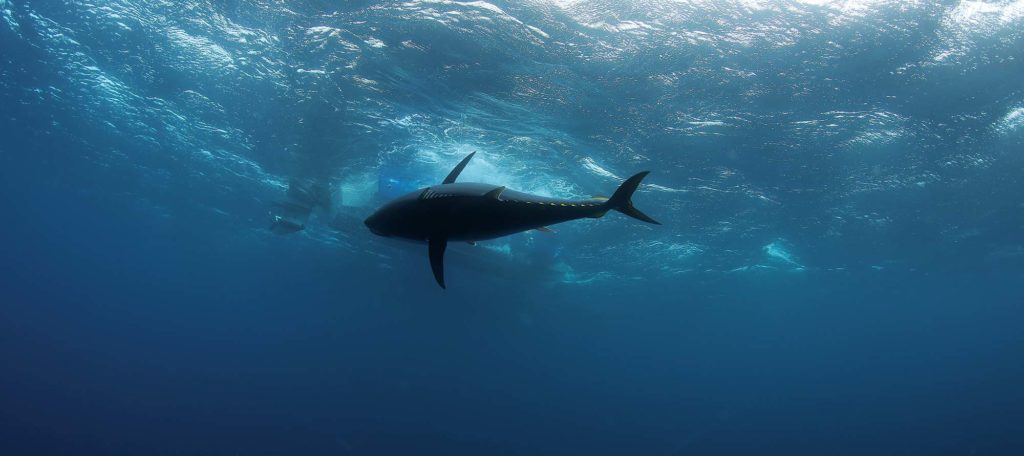
Set Up to Cast, Drop
When Rooks spots a school of bluefin on the surface or the sounder, he approaches carefully. If he sees them on the surface, he determines their direction. He positions the boat upwind with the fish to starboard so an angler in the cockpit can cast from port to starboard with the wind at his back.
Boat placement can be critical to getting a bite. “Sometimes they’ll only bite when the lure is moving down-sea,” he says. “Other days they’ll bite anything.”
When he marks the tuna on his fish finder, he puts the anglers into action. “The fish come up for a topwater plug,” he says, explaining that even if the tuna are holding 60 to 120 feet down, an angler can lure them to the surface with a big plug.
If he finds bait and other predators, he’ll have the anglers make a cast. “Sometimes you just have to give it a try. You’ll be surprised.”
From his vantage point on the bridge, Rooks can watch anglers make long casts to intercept fish. With the engine out of gear, the boat drifts toward the fish as the anglers work surface lures. The strike is explosive — big bluefin like to knock their victims into the air before crashing on the stunned prey.
If Rooks marks fish deeper than 120 feet, he instructs his anglers to drop jigs on the upwind side of the boat. The first angler drops and then moves astern, then the second angler drops. This strategy keeps the jigs working at different depths to reduce tangles.
Dropping to the correct depth is essential. The captain calls out the depth at which the fish are marking on the sounder. The anglers’ braided line is marked at every meter.
Anglers prefer the topwater plugs, though, Rooks says. “That’s all they want to do. It’s addictive.”
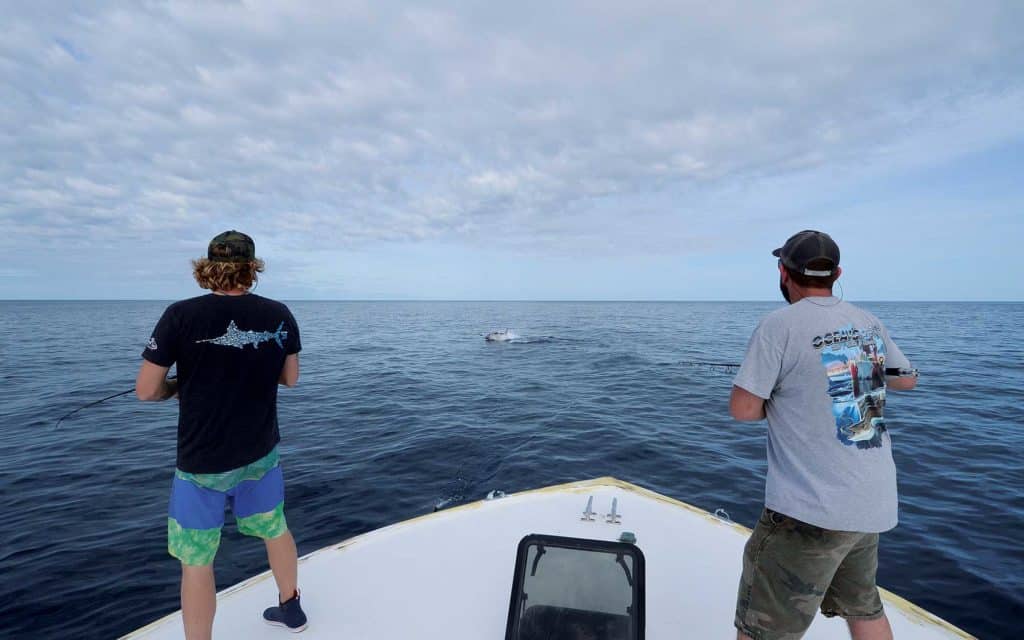
Tough Tackle
Eight years ago, when reports of bluefin tuna first leaked out of Hatteras, professional big-game angler Sami Ghandour paid attention. As owner of Saltywater tackle shop in Sayreville, New Jersey, Ghandour deals almost exclusively in light-tackle gear for monster fish. He also organizes trips around the world for topwater junkies to score bucket-list species.
Ghandour’s first bluefin trip was a big success. “We caught six out of nine fish,” he recalls. “After that, we started driving from New York to Hatteras every week.”
Since then, he has seen the bluefin grow larger each winter. “In the beginning we were catching 150- to 200-pounders,” he recalls. Last winter, they caught fish up to 650 pounds. As the tuna get bigger, the tackle and techniques must evolve.
Read Next: Bluefin Tuna Invade Southern California Waters
Ghandour’s crew has designed a tackle system that gets the job done: for casting, a 7-foot-5-inch heavy-action rod, such as a purpose-built Race Point 250 or 300, and a super-duty spinning reel, such as a Shimano Stella 18000 or Daiwa Saltiga — spooled with 130-pound hollow-core line — that offers up to 50 pounds of drag.
Terminal tackle starts with 130-pound hollow braid to 5 to 6 feet of twisted 150-pound Sunline or Varivas shock leader, attached to a 150-pound Yo-Zuri or Momoi bite leader. Ghandour sells his own twisted-leader system for tuna for $35.95 on the Saltywater website.
To the leader, he attaches a giant stickbait, such as a Hot’s Keiko Ocean Pencil 260, a CB One Ryan 230 or a Hammerhead Cherry Boy 240. The latest generation of big-game topwater lures are hand-turned and custom-painted.
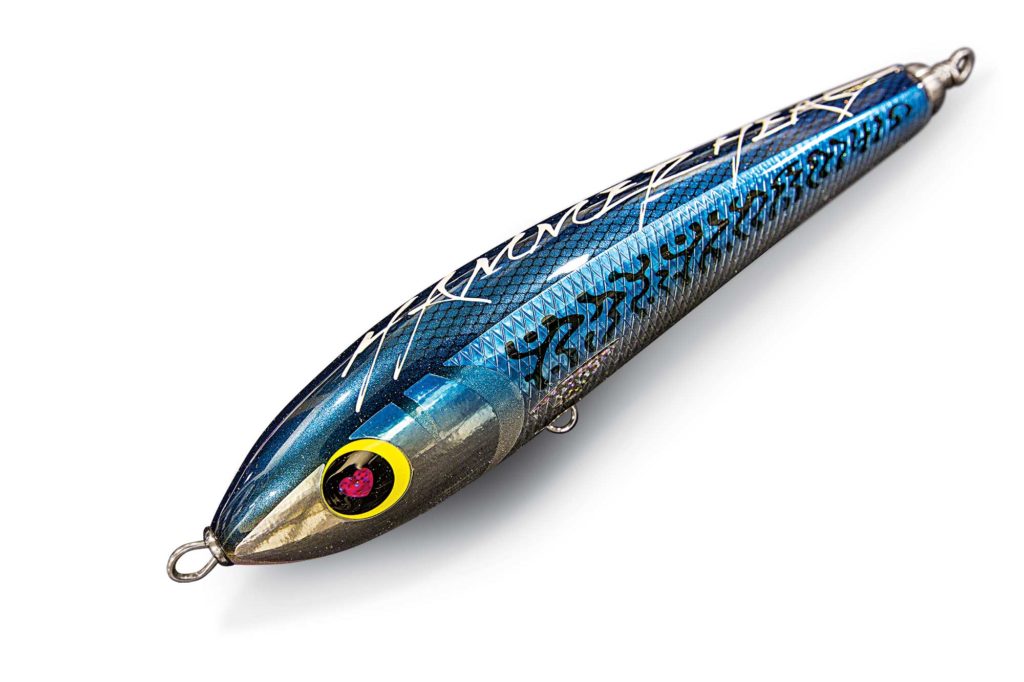
“The fish aren’t finicky, but the lure has to be bulletproof,” he says. That means through-wire construction to connect the hooks to the mainline. If the lure breaks, the wire keeps the fish attached.
“The hooks are the weak link,” Ghandour complains. Battling a sumo wrestler with 50 pounds of drag is too much for the hardware to take. “We’re going to experiment with connecting two hooks together. At this point we’ll try anything.”
For jigging, he uses a shorter rod that applies more vertical pressure to the fish with a reel such as a Shimano Stella 20000 (spin) or Studio Ocean Mark Blue Heaven L120N (conventional). “My favorite rod is 5 feet 8 inches (Saltywater Tackle Outer Banks 500 BFT),” he says. “It doesn’t beat me up like a casting rod.”
Jigging leaders begin with 150- to 175-pound fluorocarbon and a jig such as a Hot’s Drift Tune, CB One Quick Zero1 or a Zero Semilong weighing 7 to 14 ounces (200 to 400 grams).
Big-game tuna anglers usually favor spinning gear because the reel hangs below the rod and the angler doesn’t have to keep the rod upright against the powerful pull of one of these monsters.
This gear doesn’t come cheap, Ghandour says. “When you’re going for the biggest fish in the world, you need the best.”
Improvements in materials and technique have definitely made it possible to tackle bigger and bigger bluefin, but Ghandour worries about what they might face this winter. “We’ll be ready,” he assures me. “I hope.”

Giant Bluefin Techniques
Armed with the best tackle, the angler must go toe-to-toe with these beasts. From casting, dropping and working the jig to the jarring strike, unrelenting battle and vicious weather conditions, a lot of factors work against the man on the rod.
World-traveling sea-monster hunter Kil Song, of Cape Cod, Massachusetts, shows up on the Outer Banks each winter. As the owner of Black Hole rods, he tests his toughest tackle on the biggest bluefin. This year, he expects giant fish to max out his gear. “As the fish get bigger, they get harder to fool with topwater and jigs,” he says.
Fighting larger fish has encouraged anglers to develop better techniques. “We can land a 400- to 500-pound fish in 30 minutes,” Song says.
As the boat approaches a school of fish, Song lands the lure a few feet beyond the fish and works back slowly. “Hatteras bluefin are more aggressive than fish in the Northeast. They will hit a stickbait on the surface,” Song says.
Song works the lure by making long pulls on the rod interrupted with a short pause. “Hold the rod horizontal with the water,” he instructs, “and pull the lure, then reel in the slack.” Often, the fish hit as the lure floats motionless.
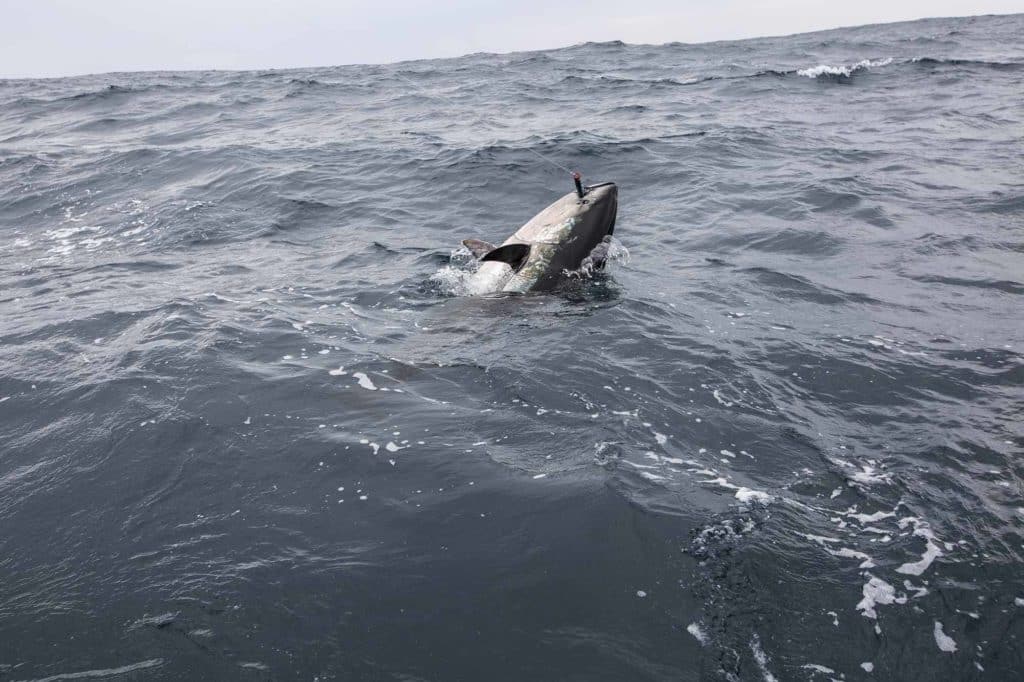
On the strike, fight the impulse to hit the fish hard. Wait for the rod tip to bend over, indicating that the tuna is moving away with the lure. “Then I hit the fish two or three times to set the hook. Expect the fish to take 300 to 400 yards of line right away.”
Once the bluefin makes its initial run, it will usually settle in for a long, vertical fight. “That’s the worst part,” Song says, laughing.
Bluefin tuna are regulated by the federal government’s fishery-management system and by international governing bodies. Regulations change constantly. Recreational anglers need special permits and must file catch reports. Check hmspermits.noaa.gov for updates and instructions.
The angler has to work closely with the captain to orchestrate the fight. Rooks tries to keep the line at a 45-degree angle to the water. “It’s a fine line between pulling on the fish and pulling on the angler,” he says. Staying in front of the fish, Rooks believes, keeps it coming toward the boat. If the tuna gets an opportunity to turn its head away from the angler, it will dig in and go to work.
That’s when 40 to 50 pounds of drag comes in handy. Song uses a bucket harness to put maximum pressure on the fish without destroying his body. “The fight is more like a marathon than a 100-yard dash,” he adds.
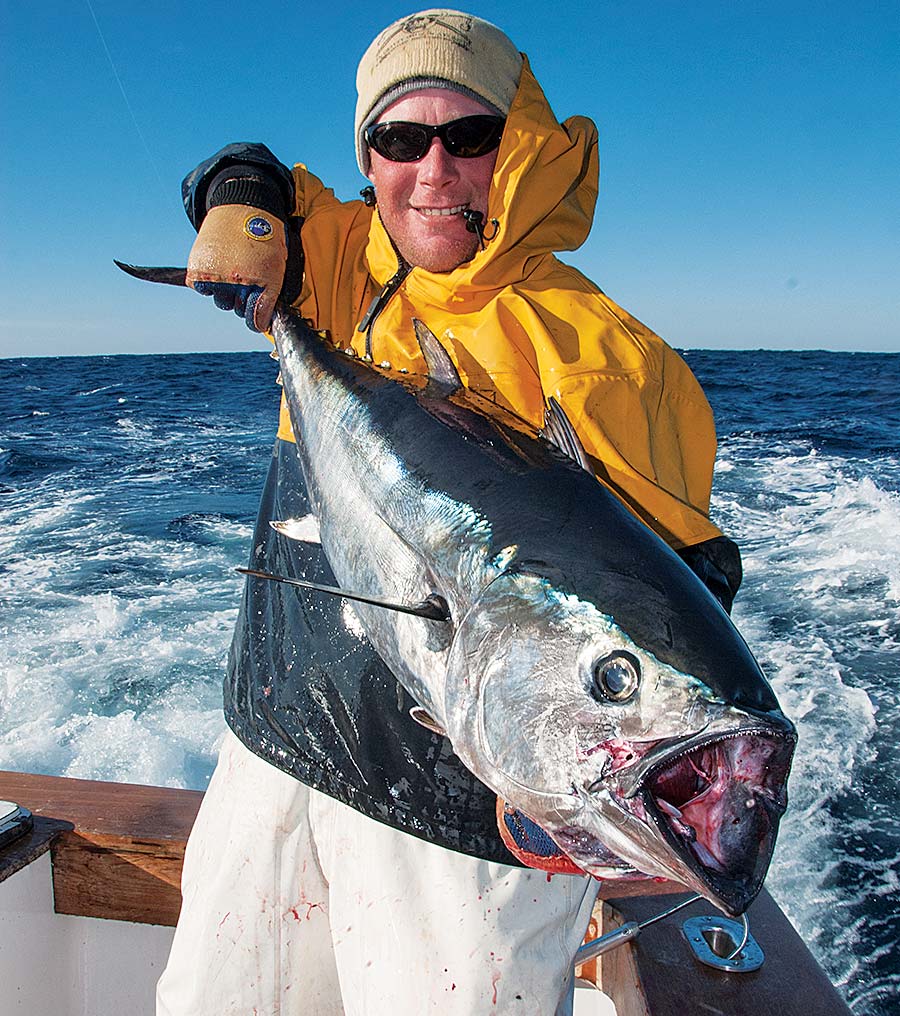
Once he’s locked into the fish, he can turn up the power. “Even if I only make a half pump and a half crank of the reel, I’m still gaining line,” he says.
Under intense pressure, the fish can’t win, unless the tackle or angler lets go.
“Expect really big fish this winter,” Song predicts. “And bring tackle heavy enough to beat them.”
About the Author: Ric Burnley is an angler, editor, author and teacher who lives in Virginia Beach. When he isn’t fishing or writing, he’s in the classroom teaching at-risk teenagers that the pen is mightier than the sword.








